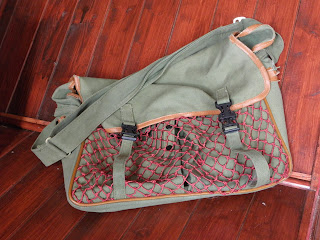In an act of eternal optimism (or maybe unshakeable faith in
his own art), a fisherman carries on his back as small wicker basket called a
creel, in which to keep his catch. At the start of the day’s sport, the creel
is lined with moss, which is moistened with river water, and fish, when caught,
are slid in through the opening in the lid where, all being equal, they will
remain fresh.
 |
| A Creel |
Creel is an odd word. It may come from the old French crielle
– ‘latticework’, with links to the Latin crātis – ‘a wickerwork hurdle’.
The OED gives the first usage from about 1425, in Andrew of Wyntoun’s The
Orygynale Cronykil of Scotland:
[Ane a payr off
coil crelis bare],
That covryt welle
wyth clathis are;
[Book 8, Ch. 38, ll.
51-2].
J O Halliwell’s Dictionary of Archaic and Provincial
Words [1855] gives it as (1) A wicker basket, North. MacLeod and Dewar’s Dictionary of the
Gaelic Language (1866) has craidhleag – ‘a basket, a creel’, but I
can find no corresponding words in Welsh, Manx, Cornish or Breton; (Dwelley’s Faclair
Gàidhlig (1902) gives a secondary meaning as a skull). The word is not
mentioned in Isaak Walton’s The Compleat Angler (1653), where you might
expect it, nor does Shakespeare use it. A creel does make a nice decorative
item though.
 |
| A Game Bag |
Another sporting item in which to carry one’s catch home is the
game bag. I used to use mine in lieu of a briefcase, as I could sling
the heavy bag on its strap over my shoulder. The bag itself has a removable,
washable, rubber-treated cotton lining, making it waterproof, and has a net
outer-bag, intended for rapidly cooling feathered or furred game, but just as
handy for an apple or orange, or a packet of sandwiches. Having taken your
game, you will need something in which to cook it.
 |
| Portmeirion Game Pie dish |
I have a pair of game pie
dishes, both of the same design, but in different colours, from Portmeirion
Pottery. In 1961, Pormeirion purchased Kirkham’s Limited in Stoke-on-Trent, and
in an abandoned attic, owner Susan Williams-Ellis found moulds for all manner
of Victorian pottery items.
 |
| Detail of the lid |
Amongst these were moulds for game pie dishes,
which Williams-Ellis modified slightly, replacing the original knob-style
handles with an ears-of-wheat relief cast from the side of the base.
 |
| Detail of the base |
The dishes
were sold from 1972, in three sizes and three colours (white, brown and blue –
although advertising from the time also shows green), but by 1974 the blue and
green dishes had been withdrawn, and the brown and white ones were withdrawn in
1977.
 |
| White Portmeirion Game Pie Dish |
Some will say that blood sports were falling from favour at the time, and
dishes decorated with dead deer, fowls and rabbits were not to everyone’s tastes, but
it’s more likely that the dishes did not sell well as the glazes tended to
craze and discolour in hot ovens, the white ones in particular suffering badly
from staining with meat juices.
 |
| Portmeirion Factory stamp on base. |
Our American cousins come over all squeamish about such matters, which is odd considering their views on shooting in
general. I love them, and use mine regularly for stew and dumplings (a
necessary staple food-group in Lancashire).
Speaking of cookery, one of my favourite
cookery books is W M W (Willie) Fowler’s Countryman’s Cooking (1965).
Willie was born in Lostock, near Bolton, Lancashire, in 1914, and served in the
RAF as a Lancaster bomber pilot before settling in Eskdale in Lakeland, where
he farmed mink and daffodils.
 |
| Willie Fowler |
His book is brilliant and if you poke about on
tinternet (here, maybe?) you can
find extracts read by the mellifluously voiced Leslie Philips for BBC Radio 4.
It is well, well worth a listen. Just to give you a feel, here is Willie’s
recipe for cormorant.
Having shot your cormorant, hold it well away from you as
you carry it home; these birds are exceedingly verminous and the lice are said
to be not entirely host-specific. Hang up by the feet with a piece of wire,
soak in petrol and set on fire. This treatment removes most of the feathers and
kills the lice. When the smoke has cleared away, take the cormorant down and
cut off the beak. Send this to the local Conservancy Board who, if you are in
the right area, will give you 3/6d, or sometimes 5/-, for it. Bury the carcase,
preferably in a light sandy soil, and leave it there for a fortnight. This is
said to improve the flavour by removing, in part at least, the taste of rotting
fish. Dig up, and skin and draw the bird. Place in a strong salt and water
solution and soak for 48 hours. Remove, dry, stuff with whole, unpeeled onions;
the onion skins are supposed to bleach the meat to a small extent, so that it
is very dark brown instead of being entirely black. Simmer gently in seawater,
to which 2 tablespoons of Chloride of Lime has been added, for 6 hours. This
has a further tenderising effect. Take out of the water and allow to dry.
Meanwhile, mixing up a stiff paste of methylated spirit and curry powder,
spread this mixture liberally over the breast of the bird. Finally, roast it in
a very hot oven for 3 hours. The result is unbelievable. Throw it away - not
even a starving vulture could eat it!
No comments:
Post a Comment